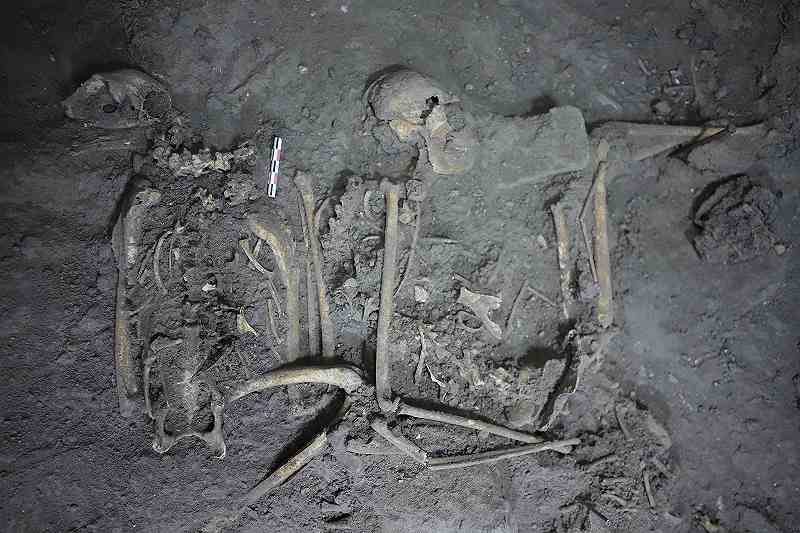
The complete skeletal remains of a 1,700 year old female spider monkey that was presented as a treasured gift is seen in this photo provided on Nov. 21.
11:37 JST, December 21, 2022
WASHINGTON (AFP-Jiji) — Seventeen hundred years ago, a female spider monkey was presented as a treasured gift — and later brutally sacrificed — to strengthen ties between two major powers of pre-Hispanic America, according to a new study.
The paper, published Nov. 21 in the Proceedings of the National Academy of Sciences (PNAS), compared the offering by Maya elites to Teotihuacan to China’s panda diplomacy that accompanied the normalization of Sino-U.S. relations in the 1970s.
By using multiple techniques — including extraction of ancient DNA, radiocarbon dating and chemical dietary analysis — researchers were able to reconstruct the life and death of the primate, finding she was likely between five and eight years of age when buried alive.
“It’s such an exciting time to be doing archaeology because the methodology is finally here,” lead author Nawa Sugiyama of the University of California, Riverside told AFP.
The work began with Sugiyama’s surprising discovery in 2018 of the animal’s remains in the ruins of Teotihuacan, a UNESCO World Heritage site in the arid Mexican Highlands.
Spider monkeys (Ateles geoffroyi) aren’t native to the elevated region, leaving Sugiyama with a puzzle to solve: What was the animal doing there, who brought it, and why was it sacrificed?
Vital clues came from the remains’ location. Teotihuacan (pronounced tay-uh-tee-waa-kaan), which lies 48 kilometers northeast of Mexico City, was an important site of cultural exchange and innovation in Classic Mesoamerica.
It’s perhaps best known for the pyramids of the Moon, Sun and Feathered Serpent. But there is increasing interest in another monument called Plaza of the Columns, a complex where neighboring Maya maintained a presence likened to a modern day embassy.
The monkey’s skeletal remains were found in the complex alongside a golden eagle — an emblem of Mexico even today — and surrounded by a collection of high-value items, including obsidian projectile points, conch shells, and precious stone artifacts.
Over 14,000 ceramic shards from a grand feast were also discovered, as well as a Maya mural depicting the spider monkey.
This, said Sugiyama, was further evidence of an exchange that took place at the highest levels, and preceded the Teotihuacan state’s later rise and military involvement in Maya cities by the year 378.
Results from chemical analysis involving two canine teeth that erupted at different points in the monkey’s life indicate that prior to captivity, she lived in a humid environment and ate plants and roots.
After being captured and brought to Teotihuacan her diet was closer to that of humans, including corn and chili peppers.
The spider monkey may have been “an exotic curiosity alien to the high elevations of Teotihuacan,” wrote Sugiyama and colleagues, with the fact she was a fellow primate possibly adding to her charisma and appeal.
Ultimately, the animal met a grisly demise: “Hands bound behind its back and tethered feet indicate en vivo burial, common among human and animal sacrifices at Teotihuacan,” the authors wrote.
"Science & Nature" POPULAR ARTICLE
-

Genome Study Reveals Milestone in History of Cat Domestication
-

Big Leap in Quest to Get to Bottom of Climate Ice Mystery
-

Security Camera Footage Vulnerable to Outside Access; Investigation Finds 3,000 Pieces Exposed Online
-

Paws on Parade: Nairobi’s Dogs Dazzle at ‘Pawchella’
-

Japan Set to Participate in EU’s R&D Framework, Aims to Boost Cooperation in Tech, Energy
JN ACCESS RANKING
-

Keidanren Chairman Yoshinobu Tsutsui Visits Kashiwazaki-Kariwa Nuclear Power Plant; Inspects New Emergency Safety System
-

Tokyo Economic Security Forum to Hold Inaugural Meeting Amid Tense Global Environment
-

Imports of Rare Earths from China Facing Delays, May Be Caused by Deterioration of Japan-China Relations
-

University of Tokyo Professor Discusses Japanese Economic Security in Interview Ahead of Forum
-

Japan Pulls out of Vietnam Nuclear Project, Complicating Hanoi’s Power Plans






















